The US corn yield forecast for 2011/12 dropped 4.9 bushels per acre this month to 148.1 bushels. Corn production prospects are reduced 417 million bushels to 12.5 billion, just 0.4 per cent higher than the previous year despite a 4.6-per cent increase in planted area.
Sustained high corn prices are expected to reduce use, with feed and residual down 200 million bushels and ethanol use and exports each down 100 million. US ending stocks are down 42 million bushels to 672 million, as high prices maintain a stocks-to-use ratio near five per cent.
World corn ending stocks are boosted this month as foreign production responds to sustained high prices. The US share of world corn trade is projected to fall below 50 per cent for the first time in 30 years.

Domestic Outlook
Feed Grain Supply and Use Down
US feed grain production in 2011/12 is forecast at 328.1 million metric tons, down 10.5 million from last month’s forecast and slightly below the 2010/11 estimate of 330.0 million.
Sharply reduced corn yield and production this month swamp a small sorghum production increase. Forecast beginning stocks are down 0.5 million tons from last month and down 21.1 million from last year. Feed grain supplies in 2011/12 are forecast at 357.3 million tons, down 11.1 million from last month primarily due to lower carry in and the decreased yield forecast for corn. Feed grain supplies are down 23.3 million tons from last year’s estimate.
Projected feed grain use for 2011/12 dropped 10.2 million tons this month to 337.6 million as sustained high prices are expected to constrain demand. Total use is forecast down 16 million metric tons from the 2010/11 projection.
Feed and residual drops 5.1 million tons from last month as high grains prices constrain livestock profitability and the smaller forecast corn crop reduces residual disappearance. Feed and residual is projected at 123.2 million tons for 2011/12, compared with the 2010/11 projection of 133.0 million. Projections for food, seed, and industrial (FSI) uses and exports each slipped 2.5 million tons from last month. Lower projected corn use for ethanol reduces feed grain FSI use.
For 2010/11, feed grain FSI is raised 254,000 tons this month due to increased corn use for high-fructose corn syrup and glucose and dextrose. Exports are also raised by the same amount to 50.6 million this month, reflecting August corn shipments. This lowers projected ending stocks by 500,000 tons to 27.0 million.
Feed Use
When converted to a September-August marketing year, feed and residual use for the four feed grains plus wheat in 2011/12 is projected to total 128.5 million tons, down 5.7 million from last month and down seven per cent from the 2010/11 forecast of 138.2 million. Corn is estimated to account for 94 per cent of the feed and residual use in 2011/12, up from an estimated 92 per cent in 2010/11.
The projected index of grain-consuming animal units (GCAU) for 2011/12 is 94.5 million units, slightly higher than the 2010/11 estimate of 92.9 million. The grain used per GCAU in 2011/12 is expected to be 1.36 tons, down from an estimated 1.49 tons in 2010/11.
Sustained high grain prices and lower residual disappearance are expected to cause the reduction in grain disappearance per GCAU. In the index components, GCAUs are decreased slightly for dairy, hogs, layers, and broilers from last month.
USDA’s Quarterly Hogs and Pigs report will be released on September 24th and will provide an indication of sow farrowing intentions into early 2011. Higher feed prices are expected to slow pork production gains and reduce feed use.
Corn Yield Cut, Production Slips this Month
US corn production in 2011/12 is forecast at 12.5 billion bushels, down 417 million from last month and only 50 million bushels above 2010/11, despite a 4.6-per cent increase in planted area.
Based on 1 September conditions, the national average corn yield is forecast at 148.1 bushels per acre, down 4.9 bushels from the August forecast and 4.7 bushels per acre below the 2010/11 yield. The current yield forecast for 2011/12 is 16.6 bushels below the 2009/10 record and would be the lowest yield since 2005/06. Despite this lower yield, production is forecast to be the third highest ever, with the second highest planted area since 1944.
Projected beginning stocks for 2011/12 are lowered 20 million bushels this month to 920 million, reflecting higher estimates of exports and FSI use during the 2010/11 season. Projected imports for 2011/12 were reduced five million bushels, and if realised, the 15 million bushels imported will be half the level imported during the 2010/11 crop year.
The reduced imports primarily reflect slower shipments from Canada due to lower production there. The resulting corn supply for 2011/12 is projected at 13.4 billion bushels, 442 million below last month’s projection and 753 million below 2010/11. Estimated 2010/11 supplies were unchanged this month at 14.2 billion bushels.
Feed and residual use for 2011/12 is lowered 200 million bushels this month, as tighter supplies and higher prices trim feed demand. Residual disappearance is also expected to decline with the smaller crop. The export projection is cut 100 million bushels as US supplies tighten relative to other producers. FSI use was lowered 100 million bushels on lower projected ethanol production based on reduced prospects for fuel consumption reported by the Energy Information.
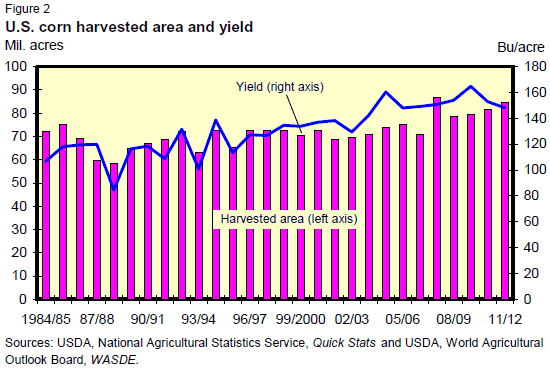

Administration. Projected 2011/12 ending stocks are lowered 42 million bushels from last month to 672 million bushels as strong prices maintain “pipeline” stocks relative to use of about five per cent.
Projected 2011/12 corn prices are increased 30 cents on each end of the range for an average of $6.50 to $7.50 per bushel, reflecting tighter supplies and reduced ending stocks. The 2010/11 estimated price was reduced 5 cents to $5.20 per bushel from the mid-point of last month’s estimated range.
Sorghum Production Advances
US sorghum production is forecast at 244 million bushels for 2011/12, an increase of 3.5 million bushels over the August forecast reflecting higher than expected yields in Texas. At the forecast level, this year’s production is still 101 million bushels below the 2010/11 harvest. Based on 1 September conditions, the sorghum yield forecast was increased 0.8 bushels per acre to 55.6 bushels per acre.
However, yields are 16.2 bushels per acre lower than last season due to drought in the southern growing regions. In Kansas, the top producing State, producers are expecting a yield of 55 bushels per acre, unchanged from last month and 21 bushels below the 2010 estimate. Producers in Texas, the second largest sorghumproducing State, expect the crop to yield 52 bushels per acre, up two bushels from last month but down 18 bushels from last year.
This month’s increased projected supplies are reflected in a forecast 3.5-millionbushel increase in ending stocks for 2011/12 compared to August.
The sorghum farm price is forecast 30 cents per bushel higher on each end or the range this month to $6.30 to $7.30 per bushel, supported by tight supplies and higher corn prices. The 2010/11 farm price forecast is lowered five cents from the mid-point of last month’s projected range to $5.15 per bushel.
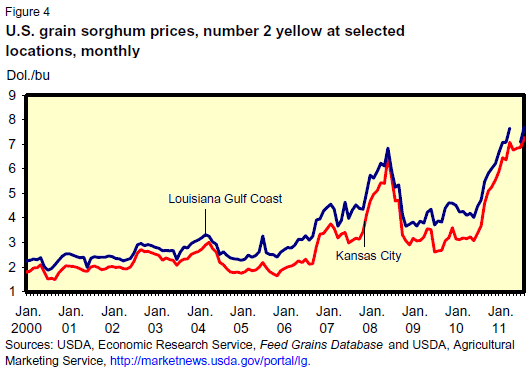
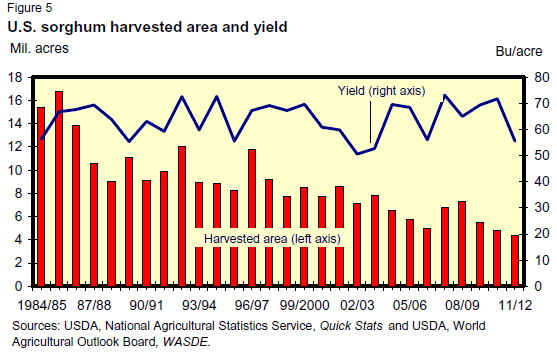
The increase in production boosts 2011/12 projected supply 3.5 million bushels to 270.759 million. Sorghum supply and use for 2010/11 was unchanged this month.
Barley and Oats Unchanged
US barley and oats production was not revised in the September Crop Production report. Any production revisions will be reported in the Small Grains 2011 Summary to be released 30 September, 2011. No changes are made this month in barley or oats supply and use.
For the 2011/12 marketing year, the projected season-average farm price for all barley is reduced 35 cents per bushel on each end of the range to $5.45 to $6.55 per bushel. While prices for feed barley are expected higher with rising feed grain values, reported prices for malting barley have been lower-than-expected. Much of the malting barley crop is raised under contract with prices set last winter and spring before planting. The 2010/11 estimated price for all barley is unchanged at $3.86 per bushel.
The 2011/12 projected oats price is unchanged at $3.40 to $4.00 per bushel. Stronger corn prices for 2011/12 are expected to support other feed grain prices; however, a substantial portion of the 2011/12 oat crop has already been marketed at prices well below current levels. The 2010/11 estimated price for oats is unchanged at $2.52 per bushel.
International Outlook
Increased Foreign Coarse Grain Production Partly Offsets US Drop
World coarse grain production in 2011/12 is projected at 1,131.2 million tons, down 5.1 million this month, but foreign production is up 5.4 million tons to 802.9 million. Most of the large changes in 2011/12 production this month are for corn.
Global millet production is up 0.4 million with increased production for Russia and Ukraine, while barley is up 0.2 million with increases for Ukraine and the EU more than offsetting a 0.7-million-ton drop for Morocco caused by excessive rains during the harvest. World oats and rye production are nearly unchanged this month, with foreign sorghum and mixed grain production unchanged.
Foreign corn production for 2011/12 is up 4.8 million tons this month as increases for Brazil, Argentina, Ukraine, and the EU more than offset reductions for Egypt and Canada. Brazil’s corn production in 2011/12 is projected to reach a record 61.0 million tons, up 4.0 million. The Brazilian Government published its final estimate of 2010/11 corn production at 57.5 million tons, up 2.0 million from last month’s USDA forecast, with increased area and production for the second crop.
Despite the late corn planting and early cutoff of rains in Mato Grosso, the seven per cent area expansion for all of Brazil in 2010/11 supported record corn production. Current strong corn prices compared to soybean prices are expected to support corn area expansion for the first-crop 2011/12 corn just now being planted in Southern Brazil, while the high prices of both corn and soybeans are expected to encourage expanded area in the Center-West for double-cropped soybeans and corn. Total corn area in 2011/12 is projected up 5 percent to 14.5 million acres, supporting another record corn crop.

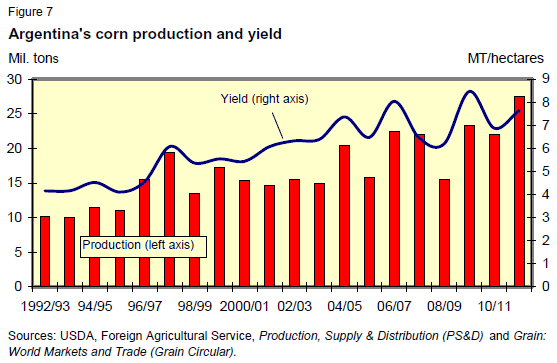
The strong prices for corn compared to soybeans are also expected to support corn area in Argentina, forecast up 12.5 percent from a year earlier. Increased area is boosting projected 2011/12 corn production 1.5 million tons this month to a record 27.5 million tons.
Corn production prospects for Ukraine are increased 1.5 million tons to 18.0 million based on early harvest reports and the good condition of the crop. Favorable temperature and rainfall during the season in most areas is confirmed by satellite imagery. Good corn yield prospects boost projected EU 2011/12 corn production 1.0 million tons this month to 61.0 million. Improved crop prospects are reported for Romania, France, Hungary, Poland, and Bulgaria.
Corn production prospects are reduced dramatically this month for Egypt, down 2.1 million tons to 3.8 million. The government is not effectively limiting access to irrigation water for rice, and with rice more profitable than corn, Egyptian producers are planting rice in place of corn. Egyptian corn area is projected to drop 39 percent to 0.52 million hectacres in 2011/12, the lowest in the USDA database back to 1960, and production is expected to be the smallest since 1985/86.
Canada’s corn yields are projected lower this month as the growing season has been less than ideal, with Ontario suffering from some of the same problems as neighboring Ohio. Canada’s 2011/12 average corn yield is forecast down 14 per cent from the previous year’s record.
Corn production prospects for the Philippines are also down slightly (0.1 million tons) due to reduced area prospects.
Increased Foreign Beginning Stocks Support 2011/12 Supplies
Foreign coarse grain beginning stocks for 2011/12 are increased 2.5 million tons this month to 135.9 million, more than offsetting the 0.5-million-ton US decline. Foreign supplies (production plus beginning stocks) for 2011/12 are projected up 8.0 million tons this month, with a 5.4-million-ton increase in production.
Most of the foreign increase in coarse grain beginning stocks is from a 1.9-millionton increase for corn. Brazil, with increased 2010/11 corn production, is projected to carry in 10.0 million tons of corn, up 1.3 million this month.
Ukraine’s 2011/12 carry-in is raised 0.5 million tons this month, and Paraguay’s is boosted 0.3 million, due to reduced 2010/11 export sales and shipments reported for the final months of the marketing year. Partly offsetting is a 0.2-million-ton reduction in beginning stocks for China because of a reduction in 2010/11 estimated imports.
World barley beginning stocks for 2011/12 are up 0.5 million tons this month to 26.1 million, mostly due to a Statistics Canada report revealing stocks 0.3 million tons higher than forecast last month by USDA. Russia’s barley stocks are boosted 0.1 million tons due to increased 2010/11 imports. Several other countries have smaller changes in barley beginning stocks.
Global oats beginning stocks for 2011/12 are up 0.2 million tons to 3.1 million, with increases for Canada and Chile. Beginning stocks of rye are reduced slightly, and sorghum is unchanged.
US Changes Cut Global Coarse Grains Consumption Prospects
World coarse grain use in 2011/12 is projected down 5.9 million tons this month to 1,144.1 million due to reduced US use. However, foreign consumption is forecast up with increased supplies. Foreign use is forecast up only 1.7 million tons to 851.2 million, as high prices limit consumption gains. Foreign corn use is up only 0.3 million tons as changes are mostly offsetting, with reductions for Egypt and Canada offset by increases for Brazil, Colombia, and changes in the sum of world trade. While the sum of local marketing year exports increased slightly this month, imports declined 0.5 million tons, increasing global disappearance.
Brazil’s corn use for 2011/12 is projected up 1.5 million tons this month to 52.0 million tons, while the previous year is estimated up 0.7 million tons to 49.5 million. Expanding poultry and pork production for domestic use and meat exports supports the five per cent growth in corn use estimated for 2010/11 and projected for 2011/12. Colombia’s 2011/12 corn use is up 0.2 million tons this month to 5.4 million based on growth in poultry production.
Corn consumption in Egypt for 2011/12 is cut 1.7 million tons to 10.4 million. Sharply reduced corn production and uncertain economic prospects cut expected food, seed, and industrial use 0.6 million tons to 1.6 million, and faltering poultry production is expected to cut feed and residual use 1.1 million tons to 8.8 million. Reduced production in Canada is expected to reduce corn feed use to 6.3 million tons, down 0.5 million this month.
World barley consumption in 2011/12 is projected up 1.0 million tons this month to 137.1 million. Increased use is projected for Saudi Arabia, up 0.5 million tons this month to 7.1 million. The Saudi Government has backed up assurances of maintaining ample supplies for feeding sheep and camels by importing aggressively in recent weeks.
Syria has also imported at a stronger rate than expected, boosting use prospects 0.2 million tons to 1.2 million. Russia, with increased beginning stocks and no incentive to build stocks during 2011/12, is expected to increase use, boosting domestic consumption 0.3 million tons this month to 14.3 million. Chile’s barley use is up slightly this month. However, with reduced production prospects, barley use in Morocco is forecast down 0.1 million tons to 3.2 million.
Increased millet production in Russia and Ukraine is boosting consumption 0.4 million tons this month. Increased oats supplies in Chile boost prospects for 2011/12 use 0.1 million tons this month.
World Corn and Coarse Grain Ending Stocks Increased This Month
Global coarse grain ending stocks for 2011/12 are projected up 2.8 million tons this month to 150.0 million. Foreign stocks are up 3.7 million tons, more than offsetting the decline in U.S. prospects. Foreign corn stocks are up 3.9 million tons, barley is down 0.3 million, and sorghum and oats are each up 0.1 million.
Brazil’s corn ending stocks for 2011/12 are up 2.8 million tons this month to 11.0 million. A combination of sharply increased production prospects and no government programme to subsidise transport for export or domestic use is expected to result in corn stocks building in Brazil during 2011/12. This month, corn ending stocks are boosted 0.5 million tons each for Argentina, Ukraine, Paraguay, and the EU.
Increased production boosts ending stocks prospects for Argentina, Ukraine, and the EU; but slow imports by Brazil are expected to cause stocks to build in Paraguay. Corn ending stocks prospects are reduced 0.5 million tons for Egypt due to reduced production, 0.2 million for China because of reduced 2010/11 imports, 0.1 million for the Philippines due to reduced area, and slightly for Chile.
Barley ending stocks prospects for 2011/12 are cut 0.6 million tons each for Morocco and Russia. Reduced production is expected to cut stocks in Morocco, while strong demand for exports and domestic use is likely to limit Russia’s barley stocks. Partly offsetting are increased stocks prospects for Canada, up 0.4 million due to increased beginning stocks revealed by a stocks survey;for the EU, up 0.3 million due to increased production; and for Saudi Arabia, up 0.2 million based on increased imports and government policy.
US Corn Exports Lowered as Competitors Increase Share
Sustained high prices for US corn are encouraging competitors’ production and exports. In 2011/12, for the first time since 1971/72, the US share of the world corn market is expected to fall below 50 per cent.
This month, US corn exports for trade year 2011/12 are reduced 3.0 million tons to 42.0 million (down 100 million bushels to 1.65 billion for the September-August local marketing year). Reduced US production and high prices are expected to limit demand, including exports. As of 1 September, outstanding export sales were 13.2 million tons, down from 15.1 million a year earlier.
High corn prices relative to those for other crops are helping boost competitors’ production. Ukraine, with expanded area and record yields is expected to export 10.0 million tons of corn, up 1.5 million this month. Brazil and Argentina, in the Southern Hemisphere, have increased 2011/12 production prospects this month, but that production will be available for only a portion of the October-September trade year.
Trade year 2011/12 export prospects for the two countries are up 0.5 million tons each to 8.5 and 18.0 million, respectively. EU corn exports are up 0.5 million tons to 1.5 million, boosted by increased production and attractive prices outside the EU. Both Romania and Bulgaria are in a good position to ship to markets outside the EU.
Canada’s corn export prospects for 2011/12 are cut in half, down 0.5 million tons to 0.5 million, because of reduced production prospects. Paraguay’s exports are reduced 0.2 million tons to 1.5 million due to weak import demand from neighboring Brazil.
World corn trade for 2011/12 is projected 0.7 million tons lower this month to 92.1 million. Brazil’s corn imports are cut 0.5 million tons to 0.5 million as large domestic production makes imports less attractive. Egypt’s import forecast is trimmed 0.1 million tons to 6.0 million due to uncertain prospects for the poultry sector there. US corn imports are reduced 0.1 million tons to 0.4 million due to tight supplies in Canada. However, imports for Colombia are raised 0.2 million tons to 3.9 million as growth in the pork and poultry sectors has been stronger than earlier expected.
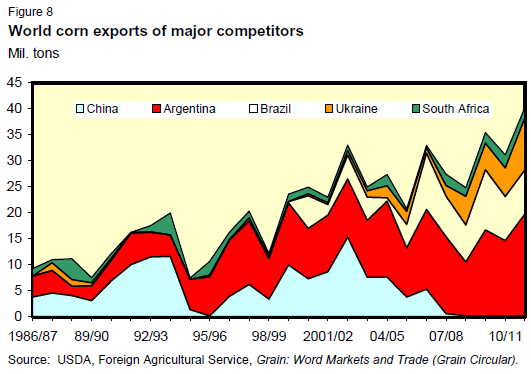
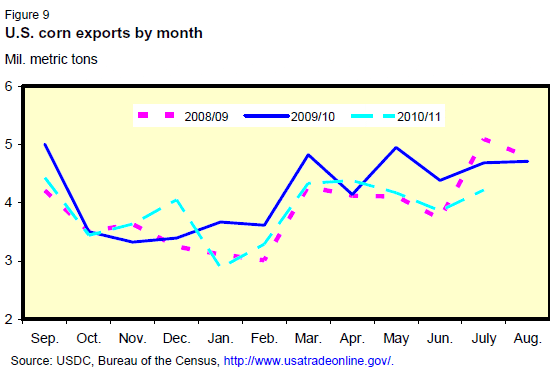
World corn trade forecast for 2010/11 was adjusted down 0.3 million tons to 91.7 million tons. Argentina’s exports are raised 0.5 million tons to 15.0 million and Ukraine’s are reduced 0.5 million to 5.5 million, both based on the pace of shipments in recent months. Imports by Brazil, China, and Chile are each trimmed 0.2 million tons because of the slow pace of recent shipments and purchases.
The pace of US shipments for 2010/11 supports the 46.0 million tons forecast for the October-September trade year. Census data for October through July reached 38.3 million tons, and August grain inspections were 3.7 million. If the August Census number comes in a bit higher than inspections, as is normal, and if September 2011 shipments fall modestly from those of the previous year, exports will be on pace. The 2010/11 local marketing year (September-August) exports are increased 10 million bushels to 1,835 million based on the August inspections.
World Sorghum Trade Boosted Slightly
Global sorghum trade in 2011/12 is projected up 0.2 million tons this month to 6.2 million. Australia’s export prospects are increased 0.2 million tons to 1.0 million. Import prospects for Colombia and Chile are each increased 0.1 million tons based on increased imports estimated for the previous year.
World sorghum trade forecast for 2010/11 is reduced slightly, with a 0.2-millionton increase for Argentina more than offset by a 0.3-million-ton reduction for Australia. Australia’s shipments to Japan have lagged expectations, trimming Japan’s imports 0.3 million tons to 1.3 million. However, Argentina’s shipments to Colombia and Chile exceeded expectations.
US sorghum exports for 2010/11 are on pace to reach 3.8 million tons for the trade year and 150 million bushels for the local year based on August inspections of 3.3 million, slightly above a year earlier.
Global Barley Trade Prospects Increase
World barley trade for 2011/12 is increased 0.9 million tons this month to 15.4 million. Saudi Arabia has been buying aggressively and has demonstrated it intends to maintain ample supplies. Saudi imports are increased 0.7 million tons this month to 7.0 million. Syria’s imports are increased 0.2 million tons to 0.5 million due to strong demand.
Further Reading
| - | You can view the full report by clicking here. |
September 2011


